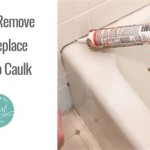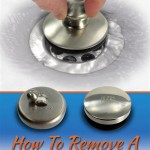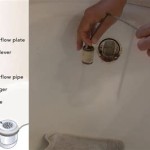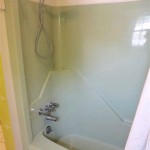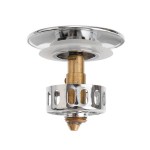How Long Do Bathtub Refinishing Fumes Last?
Bathtub refinishing, also known as bathtub reglazing or resurfacing, is a cost-effective alternative to replacing an old or damaged bathtub. The process involves cleaning, repairing, and applying a new coating to the existing surface. While it can significantly extend the life and improve the appearance of a bathtub, it's crucial to understand the potential drawbacks, particularly concerning the fumes emitted during and after the refinishing process. These fumes can pose health risks, and understanding their duration and mitigation strategies is essential for a safe and successful refinishing project.
The fumes associated with bathtub refinishing originate primarily from the chemicals used in the process. These chemicals typically include strong solvents, adhesives, and coatings, all of which contain volatile organic compounds (VOCs). VOCs are organic chemicals that easily vaporize at room temperature, releasing gases into the air that can be harmful to human health. The type and concentration of VOCs emitted will vary depending on the specific products used, the application techniques, and the ventilation conditions.
Beyond the immediate discomfort of strong odors, exposure to bathtub refinishing fumes can lead to a range of health effects, both short-term and potentially long-term. These effects can vary in severity depending on individual sensitivity, the concentration of the fumes, and the duration of exposure. Therefore, understanding how long these fumes persist and implementing appropriate safety measures is paramount.
Factors Influencing the Duration of Bathtub Refinishing Fumes
Several factors influence how long bathtub refinishing fumes will linger in a home. These factors include the type of products used, the quality of ventilation, the temperature and humidity levels, and the thoroughness of the cleanup process. Understanding these factors allows homeowners and professionals to better estimate the fume duration and implement strategies to minimize their impact.
Type of Products Used: The specific chemicals used in the refinishing process are the most significant determinant of fume duration. Products with higher concentrations of VOCs will generally produce stronger and longer-lasting fumes. Some refinishing kits and professional-grade coatings contain more aggressive solvents designed for durability and adhesion, but these also tend to release more fumes. Water-based coatings, while often marketed as low-VOC options, may still contain some VOCs and can produce noticeable odors. Always review the Material Safety Data Sheet (MSDS) for each product used to understand the specific chemicals involved and their potential health effects. The MSDS provides crucial information about the chemical composition, hazards, and recommended safety precautions.
Quality of Ventilation: Proper ventilation is critical for dissipating fumes quickly and effectively. Adequate airflow helps to dilute the concentration of VOCs in the air and encourages their removal from the environment. Poor ventilation, on the other hand, traps fumes indoors, prolonging their duration and increasing the risk of exposure. Natural ventilation, such as opening windows and doors, can be effective in mild weather. However, mechanical ventilation, such as using exhaust fans and air purifiers with activated carbon filters, is often necessary for optimal fume removal, especially in enclosed spaces or during periods of extreme temperatures.
Temperature and Humidity: Temperature and humidity can significantly impact the rate at which VOCs evaporate and dissipate. Warmer temperatures generally accelerate the evaporation process, leading to higher initial concentrations of fumes. Conversely, colder temperatures can slow down evaporation, but may also prolong the overall duration of the fumes. High humidity levels can also affect the evaporation rate and can make the air feel more saturated with odors. Maintaining moderate temperature and humidity levels during and after the refinishing process can help to optimize fume dissipation.
Thoroughness of Cleanup: Proper cleanup after the refinishing process is essential for minimizing residual fumes. This includes removing all used materials, such as rags, brushes, and empty containers, from the work area. Spills or drips of refinishing chemicals should be cleaned up immediately with appropriate cleaning agents. Thorough cleaning helps to eliminate potential sources of ongoing VOC emissions and contributes to a faster reduction in fume levels. Consider using a specialized VOC absorbent material for any significant spills to contain and neutralize the chemicals effectively.
Expected Fume Duration and Mitigation Strategies
While predicting the exact duration of bathtub refinishing fumes is challenging due to the variability of the factors mentioned above, general estimates can be provided. Additionally, a range of mitigation strategies can be implemented to minimize the impact of the fumes and accelerate their dissipation.
Typical Fume Duration: In general, strong fumes from bathtub refinishing can be expected to last for several days, often ranging from 2 to 7 days. In some cases, a faint odor may linger for several weeks, particularly if ventilation is inadequate or if low-VOC products were not used. The most intense fumes are typically present during and immediately after the application of the coating. The concentration of fumes will gradually decrease over time as the VOCs evaporate and are dispersed. It's important to continue monitoring the air quality and implementing ventilation strategies until the fumes are no longer detectable.
Ventilation Techniques: Maximizing ventilation is the most effective way to reduce fume duration. Open all windows and doors in the bathroom and surrounding areas during and after the refinishing process. Use exhaust fans to draw air out of the bathroom and vent it to the exterior of the building. Consider using portable fans to circulate air and promote evaporation. If weather conditions permit, leave windows and doors open for extended periods to allow for continuous airflow. When using mechanical ventilation, ensure that the air is being exhausted to the outside and not simply recirculating within the building.
Air Purification: Air purifiers equipped with activated carbon filters can help to remove VOCs from the air. Activated carbon is highly effective at absorbing a wide range of organic chemicals. Place an air purifier in the bathroom or adjacent areas to capture and neutralize the fumes. Ensure that the air purifier is appropriately sized for the room and that the filter is regularly replaced according to the manufacturer's recommendations. HEPA filters, while effective at removing particulate matter, are not designed to remove VOCs, so an activated carbon filter is essential for addressing bathtub refinishing fumes.
Sealing the Area: To prevent fumes from spreading to other parts of the house, seal off the refinishing area as effectively as possible. Close the bathroom door and use painter's tape and plastic sheeting to seal any gaps around the door frame. Cover any vents or openings that could allow fumes to escape. This helps to contain the fumes within a smaller area and prevents exposure to other occupants of the house. Be sure to remove the sealing materials carefully after the fumes have dissipated to avoid releasing any trapped VOCs into the rest of the home.
Personal Protective Equipment (PPE): During the refinishing process, it is essential to wear appropriate personal protective equipment to minimize exposure to fumes. This includes a respirator with an organic vapor cartridge, gloves, and eye protection. The respirator will filter out harmful VOCs and prevent them from being inhaled. Gloves will protect the skin from contact with the chemicals. Eye protection will prevent splashes or fumes from irritating the eyes. Ensure that the respirator is properly fitted and that the cartridge is appropriate for the specific chemicals being used. Consider hiring a professional who is trained in the safe handling of refinishing chemicals and who has access to appropriate PPE.
Health Considerations and Precautions
Exposure to bathtub refinishing fumes can pose significant health risks, particularly for individuals with pre-existing respiratory conditions, allergies, or sensitivities to chemicals. Therefore, it’s crucial to understand the potential health effects and take appropriate precautions to protect yourself and others. Recognizing the symptoms of fume exposure and knowing when to seek medical attention is also essential.
Potential Health Effects: Short-term exposure to bathtub refinishing fumes can cause a range of symptoms, including headache, nausea, dizziness, eye and throat irritation, and difficulty breathing. In more severe cases, it can lead to coughing, wheezing, and even respiratory distress. Long-term exposure to high concentrations of VOCs has been linked to more serious health problems, such as damage to the nervous system, liver, and kidneys. It's important to be aware of these potential health effects and to take steps to minimize exposure.
Vulnerable Populations: Certain populations are particularly vulnerable to the effects of bathtub refinishing fumes. These include pregnant women, children, the elderly, and individuals with respiratory conditions such as asthma or bronchitis. Exposure to VOCs during pregnancy can potentially harm the developing fetus. Children are more susceptible to the effects of VOCs because their bodies are still developing and they have higher breathing rates. The elderly and individuals with pre-existing respiratory conditions may experience more severe symptoms from fume exposure. It is crucial to take extra precautions to protect these vulnerable populations.
When to Seek Medical Attention: If you experience severe symptoms after being exposed to bathtub refinishing fumes, such as difficulty breathing, chest pain, or loss of consciousness, seek immediate medical attention. Even if the symptoms are mild, it's a good idea to consult with a doctor or other healthcare professional if you have any concerns about your health. Provide the doctor with information about the specific chemicals used in the refinishing process, if possible, as this can help with diagnosis and treatment.
Alternative Options: Before opting for bathtub refinishing, consider alternative options that may be less hazardous, such as replacing the bathtub entirely. While replacement may be more expensive, it eliminates the risk of exposure to harmful fumes. If refinishing is the only feasible option, research and select low-VOC products whenever possible. Consult with a professional refinisher who is knowledgeable about safe practices and who uses environmentally friendly products. Prioritize safety and health when making decisions about bathtub renovation projects.

What Are The Health Risks Of Bathtub Reglazing Fumes Angi

Dangers Of Bathtub Refinishing Blogs Cdc

How To Reduce Tub Reglazing Fumes With The 280 Low Voc Glaze Topkote

How Long Should Your Bathtub Last After Reglazing Badeloft

How Long Should Your Bathtub Last After Reglazing Badeloft

Bathtub Refinishing Happy Tubs Repair

How Long Should Your Bathtub Last After Reglazing Badeloft

How Bathtub Refinishing Can Improve The Value Of Any Home

How Long Should Your Bathtub Last After Reglazing Badeloft

How Long Should Your Bathtub Last After Reglazing Badeloft
Related Posts

